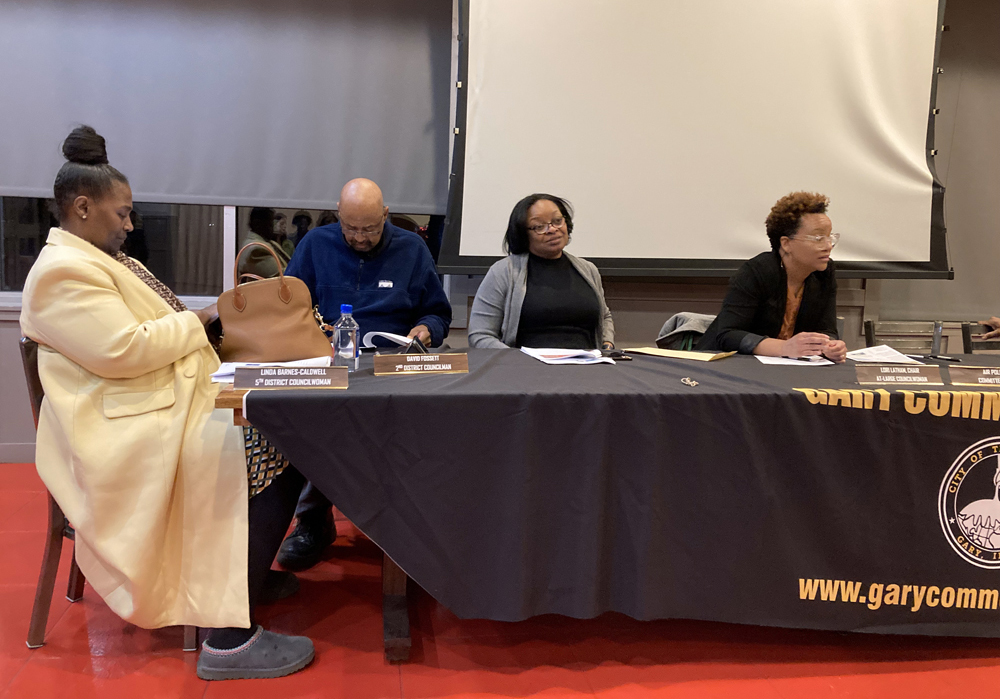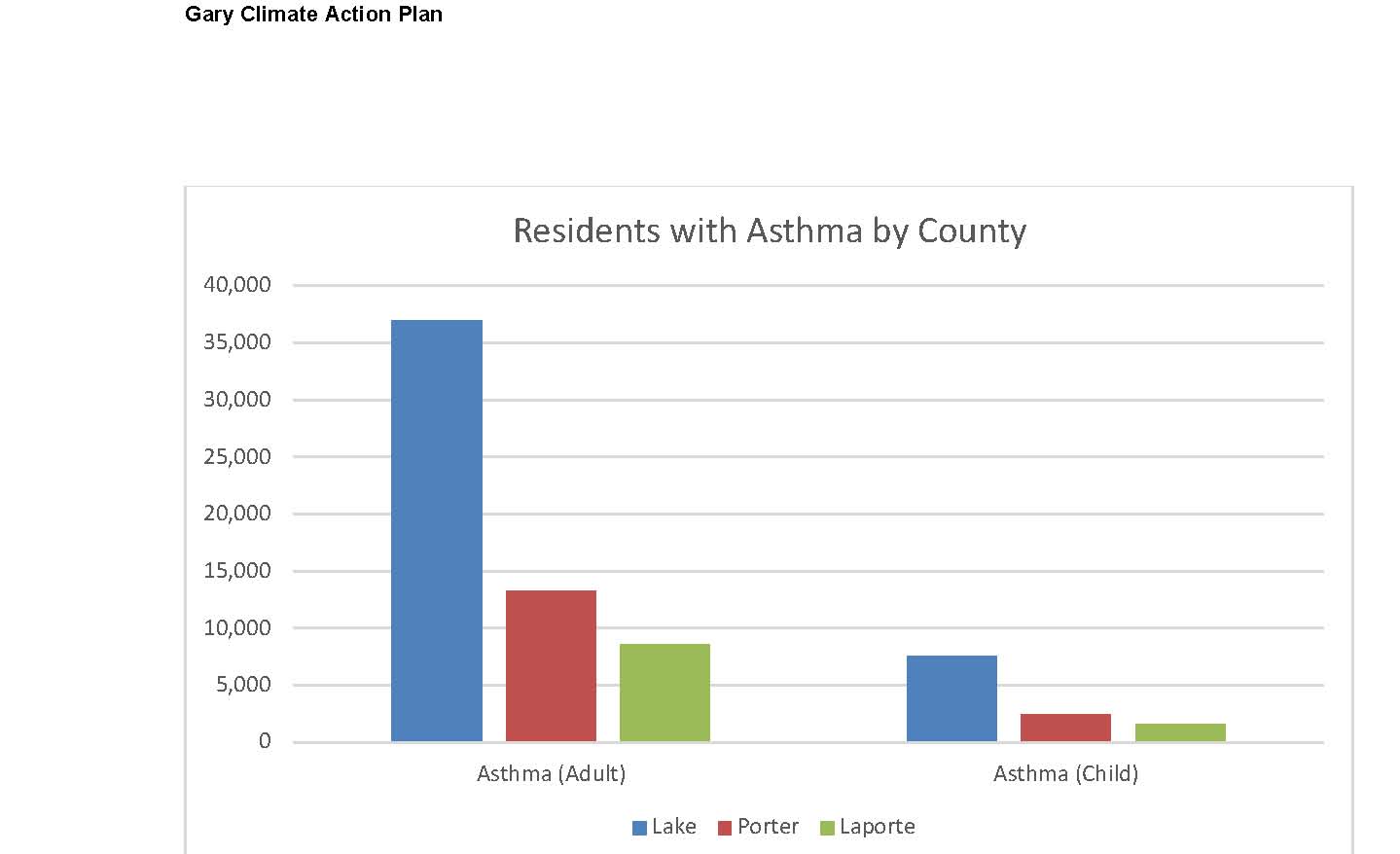
At the Air Pollution Advisory Committee meeting, (l-r) Councilwoman Linda Barnes-Caldwell, Councilman David Fossett, Brenda Scott-Henry, and Lori Latham
Air Pollution meets the Climate Action Plan in Gary
Contributed By:The 411 News
Revived city council committee wants to learn more about greenhouse gas emissions
Gary’s Climate Action Plan overview took up all of the time at the Gary city council’s recent Air Pollution Advisory Committee meeting.
Brenda Scott-Henry, Director of Sustainability and Environmental Affairs said the city’s Climate Action Plan was completed in 2020 and is undergoing modifications.
Reducing greenhouse gases, primarily carbon dioxide emissions, is the goal of Gary’s plan and CAPs across the nation, taking leads from the 2016 Paris Climate Agreement’s response to threats of global warming and climate change.
The majority of greenhouse gases come from the industrial burning or combustion of fossil fuels (coal, oil, natural gas) that provide energy for manufacturers including water, gas, and electric utilities plants; and from producers of products that power automobiles, trucks, trains, and airplanes. Burning those fuels releases carbon dioxide (CO2) into the Earth’s atmosphere, where it settles instead of escaping into outer space.
As carbon dioxide accumulates in the atmosphere, it absorbs heat escaping from the Earth’s surface and releases it, leading to warmer temperatures on the Earth below. The effect has become climate change – a disruption of average temperatures and normal weather patterns.
Climate action plans have spotty implementations in northwest Indiana. Hammond and East Chicago don’t have plans. According to Gary’s CAP, United States Steel has set a 20% greenhouse gas emissions reduction goal, but that is the sum across all of its facilities in the country. None of the oil refineries here have set GHG reduction goals.
NIPSCO, northern Indiana’s gas and electric utility, is on the way to total elimination of coal for electricity generation. The utility is replacing coal with wind and solar power.
Climate action plans may include additional components such as resilience strategies, clean energy targets, and economic and social goals. Gary’s CAP asked the question: “How can we prepare and plan for the impacts of climate change on the unique assets, resident wellbeing, and future of the City of Gary?”
Gary’s plan uses a 7-sector approach to reducing GHG emissions. GHG emissions are identified from each sector with ways to reduce them and with target dates.
One of the impacts of climate change in the U.S. is a change in air quality and how it can affect human health. Air quality is one of the seven sectors.
Air Pollution Advisory Committee chair Lori Latham didn’t know the last time the committee had met. “It’s been awhile. I didn’t even know the council had an air pollution committee.” Latham wants the committee to be active and hold meetings on a regular basis. “We need to begin to consider resolutions or policies for the council to consider, to improve our air quality.”
City council president William Godwin said the committee has never met since he’s been on the council. “It’s amazing that Latham activated it. She brings a strong skill set in this area and will be a big asset in helping the city assess our environmental condition.'
In Gary’s CAP, it notes the 2018 State of the Air report from the American Lung Association placed Chicago and northwest Indiana in the top 25 most polluted areas in the U.S. for air quality. Also, the U.S. Environmental Protection Agency’s Toxic Release Inventory said industrial pollution is found to be highest in the Midwest, with Indiana leading the nation in toxic pollution emitted per square mile.
According to Gary’s plan, ”The negative health impacts of pollution on chronically ill residents affect residents in Gary, and Lake County more generally, more than residents in neighboring counties like Porter County and Laporte County.”
The plan identifies two climate-related air quality goals: Reduce the number of days that inhalable particles are in the air and reduce the number of high ozone days by 2025.
When the particles are inhaled, they are deposited in the lungs, causing health problems in young children and in adults with heart and respiratory diseases.
Ground level ozone, not to be confused with the good ozone in the upper atmosphere, irritates and inflames the airways, causing difficulty in breathing. For asthma sufferers, more warm days could bring more high ozone days. It could mean more missed days at work or school, more visits to doctors or hospital emergency rooms.
Scott-Henry said asthma affects 13-14% of Gary’s children and adults.
The second goal is to develop a residential communication and education program. The program will notify residents of air quality resources, issue health advisories, educate residents about air quality impacts on health, and what to do (or not do) on poor air quality days.
”The City of Gary cannot meet those goals alone. We can recommend to our industrial partners they reduce emissions on those days,” Scott-Henry said.
The six other sectors in Gary’s CAP are: the Built Environment, Economic Vitality, the Green Environment, the Natural Environment, Transportation, and Waste.
Latham said she’s passionate about air quality. Latham is also a member of GARD (Gary Advocates for Responsible Development). The group filed a lawsuit against the Indiana Department of Environmental Management after the agency granted an air permit for Fulcrum BioEnergy to operate a facility in Gary’s Buffington Harbor that will convert trash to jet fuel.

Asthma in Lake, Porter, and Laporte counties
Story Posted:03/06/2023
|